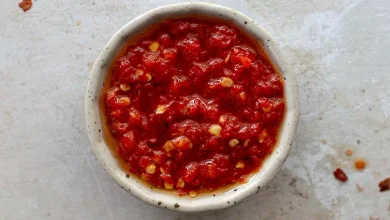🥢🍲 Asian-Style Meatballs 🥢🍲
Asian-style meatballs are a delectable dish inspired by the rich and diverse culinary traditions of Asia. They are known for their unique blend of flavors and textures, often combining savory, sweet, and spicy elements. These meatballs can be made from various meats, such as pork, chicken, beef, or even a combination of these, and are often served with a delicious sauce.
📜 History:
The history of Asian-style meatballs is quite fascinating, as it reflects the influence of different Asian cuisines. Meatballs are a widespread dish in many Asian cultures, each with its own distinct variations and flavors. For instance, you can find Chinese lion’s head meatballs, Japanese tsukune, Thai moo pad krapow, and more. Over time, Asian-style meatballs have evolved to incorporate regional ingredients and techniques, creating a diverse and flavorful array of dishes.
🍽️ Components:
The components of Asian-style meatballs typically include:
- Ground Meat: This is the primary ingredient, which can be pork, beef, chicken, or a combination of these.
- Aromatics: Garlic, ginger, scallions, and sometimes lemongrass or cilantro are often used to infuse the meatballs with flavor.
- Binding Agent: Eggs, breadcrumbs, or starch (such as cornstarch or tapioca starch) help hold the meatballs together.
- Seasonings: Soy sauce, fish sauce, oyster sauce, and various spices are used to season the meat.
- Herbs and Spices: Ingredients like cilantro, Thai basil, or chili flakes can be added for additional depth of flavor.
👩🍳 Preparation Steps:
Here’s a general guideline for preparing Asian-style meatballs:
-
Prepare the Meat: In a mixing bowl, combine the ground meat of your choice with finely chopped aromatics (garlic, ginger, scallions, etc.).
-
Add Binders: Mix in your chosen binding agent (breadcrumbs, eggs, or starch) to help the meatballs hold their shape.
-
Seasoning: Add seasonings like soy sauce, fish sauce, oyster sauce, and any herbs or spices you desire. Adjust these to your taste.
-
Mix Thoroughly: Using your hands, mix all the ingredients together until well combined. Ensure the meat mixture is evenly seasoned.
-
Shape the Meatballs: Take a portion of the mixture and form it into meatballs of your preferred size. Asian-style meatballs are often smaller than Western meatballs.
-
Cooking: You can choose to fry the meatballs in a pan, bake them in the oven, or even steam them. The method may vary depending on the specific recipe you’re following.
-
Sauce: Many Asian-style meatball dishes come with a flavorful sauce. It can be sweet and sour, savory, or spicy, depending on the regional variation. Prepare the sauce separately and drizzle it over the cooked meatballs.
-
Serve: Garnish your meatballs with fresh herbs, sesame seeds, or chopped nuts, and serve them hot. They are commonly served with rice or noodles.
⏰ Preparation Time:
The time needed to prepare Asian-style meatballs can vary depending on the complexity of the recipe and the cooking method. On average, it may take around 30-45 minutes to prepare and cook the meatballs. However, this can vary widely, so be sure to consult a specific recipe for accurate timing.
Enjoy your Asian-style meatballs – a delicious fusion of Asian flavors in bite-sized form! 🥢🍲😋
Certainly! Here are some general nutrition facts and health information related to Asian-style meatballs:
📊 Nutrition Facts (Approximate, per serving):
-
Calories: The number of calories in a serving of Asian-style meatballs can vary depending on the type of meat used and the specific ingredients in the recipe. On average, a serving may contain between 150-250 calories.
-
Protein: Meatballs are a good source of protein, with about 15-20 grams of protein per serving, depending on the meat used.
-
Fat: The fat content can also vary, but it’s typically around 10-15 grams of fat per serving. Leaner meat choices will have lower fat content.
-
Carbohydrates: Asian-style meatballs often contain minimal carbohydrates, with around 5-10 grams of carbohydrates per serving.
-
Fiber: Meatballs typically don’t contain significant amounts of dietary fiber.
-
Sodium: The sodium content can be relatively high due to the use of soy sauce, fish sauce, and other seasonings. A serving might contain 400-800 milligrams of sodium or more.
🍽️ Health Information:
-
Protein: Meatballs, especially if made from lean meats like chicken or turkey, are a good source of protein, which is essential for muscle growth and repair.
-
Fat: Be mindful of the fat content in meatballs, especially if you’re using fatty cuts of meat. Opting for leaner meats can reduce the fat content and overall calorie count.
-
Sodium: The high sodium content is something to watch out for, as excessive sodium intake can lead to high blood pressure. Consider using lower-sodium soy sauce or tamari and controlling the amount of salt in the recipe.
-
Aromatics and Herbs: The use of garlic, ginger, scallions, and herbs in Asian-style meatballs can provide various health benefits. These ingredients are known for their antioxidant properties and potential health benefits.
-
Sauce: The sauce used with Asian-style meatballs can significantly impact the overall nutrition. Be cautious with sweet and high-sugar sauces, as they can add extra calories and sugar to your meal.
-
Serving Size: Pay attention to portion sizes. Asian-style meatballs are often served as part of a larger meal with rice or noodles, so consider the overall balance of your plate.
-
Customization: You can make Asian-style meatballs healthier by using lean meats, reducing sodium, and including plenty of vegetables in the dish. This can boost the nutritional value and fiber content.
Remember that the exact nutrition facts and health impact will vary based on the specific recipe and ingredients you use. If you have dietary restrictions or health concerns, it’s a good idea to consult with a healthcare professional or nutritionist for personalized advice on incorporating Asian-style meatballs into your diet.



